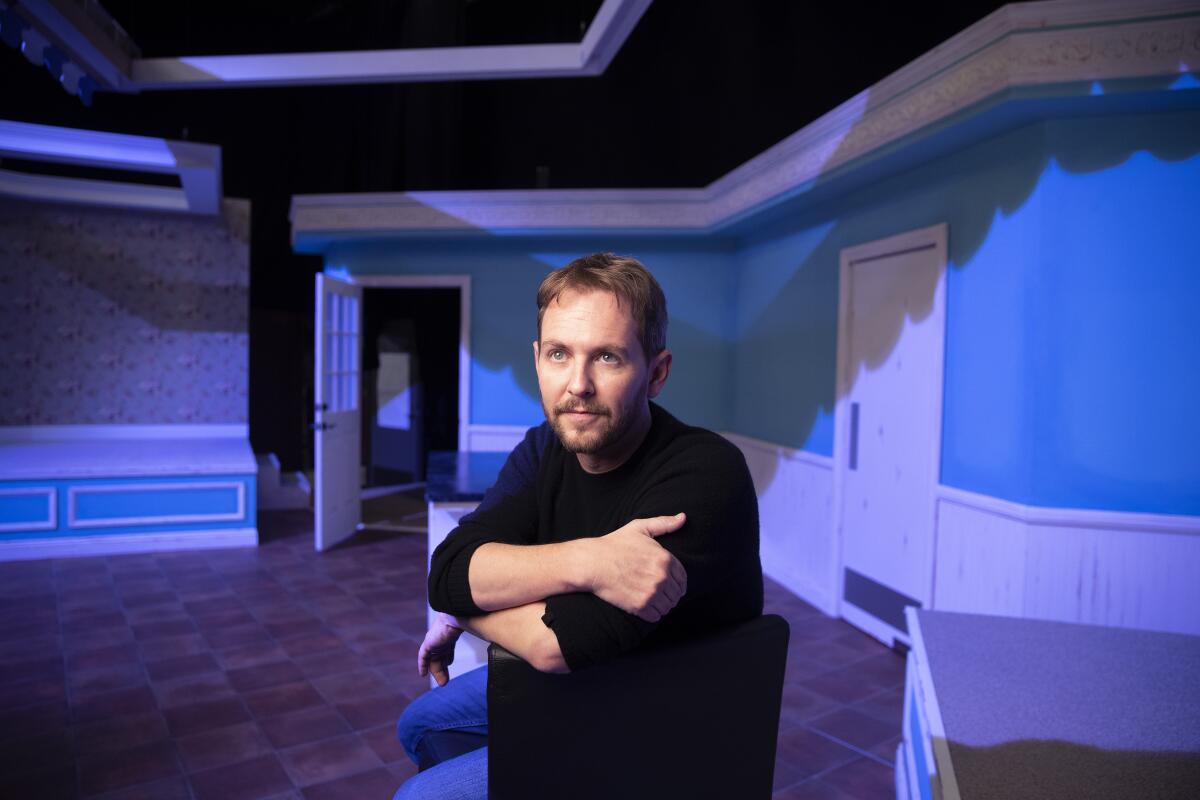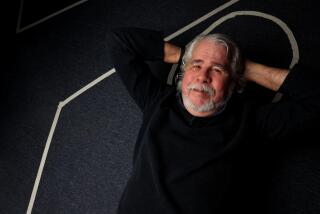Commentary: Torn between two careers: Matt Shakman and the dilemma of the starry-eyed Geffen Playhouse

After successfully riding out the COVID pandemic with a string of highly lucrative digital theater offerings, the Geffen Playhouse has run into difficulties.
The great reopening has been overwhelming for theaters generally. Reluctant audiences, successive waves of more transmissible variants, shifting COVID protocols, the drying up of governmental support, escalating operating costs, a fiercely contentious cultural environment â how any artistic leader can manage these simultaneous challenges is daunting to contemplate.
But the Geffen has had the added burden of meeting this moment with one hand tied behind its back. Matt Shakman, the theaterâs artistic director, has been building a flourishing career as a television director, with credits on his rĂŠsumĂŠ that include âGame of Thrones,â âSuccessionâ and âThe Good Wife.â After directing the Disney+ miniseries âWandaVision,â heâs in talks to direct Marvelâs âFantastic Fourâ reboot, which would catapult him into the Hollywood big leagues.
Congratulations to Shakman, but the Geffen Playhouse has artistically struggled in the wake of his success.
Few were surprised when the Geffen announced last month that Shakman would be stepping down. Managing two careers, even for someone this prodigiously gifted, is a losing game. Something eventually has to give.
In an interview with The Timesâ Jessica Gelt, Shakman said that it was increasingly difficult to find the balance between theater and screen work and that looking ahead he didnât think heâd be able to âdo the best for the Playhouse.â It was a responsible decision, but the theater needs to ask itself why it was willing to go along with such an arrangement in the first place.
History holds a clue. Gil Cates, the founder of the Geffen Playhouse who served as president of the Directors Guild of America and regularly produced the Oscars telecast, established the model of a dual track career at his Westside theater. He wanted the Geffen Playhouse to be a place that Hollywood would call home.
There was a time when movie and television stars saw the stage as career suicide. To this day, casting for many high-profile L.A. productions takes place in New York. Industry movers and shakers here have little interest in the chump change of theater even when it involves a major opening at the Mark Taper Forum.
But Cates personally lived out his dream. When we would have our annual lunch at the Grill on the Alley in Beverly Hills, agents and producers would come over to our table to check in with one of this townâs legendary schmoozers.
Randall Arney, a Steppenwolf Theatre Company veteran, was brought in to lead the Geffen Playhouse in 1999 and perhaps give it some Chicago grit. The audience and perhaps more consequently the board of directors cultivated by Cates, who died in 2011, may have preferred their grit with a bit more stardust. In 2017, Shakman was appointed to succeed Arney, who subsequently filed an age discrimination lawsuit.
Much was made in the announcement of Shakmanâs âacclaimedâ directing career. His TV credits were arrayed in the news release like peacock feathers. And assurances were made that he would continue âto direct for television and film while serving in his new role.â
The powers that be clearly recognized which side Shakmanâs prestige came from. Whatâs surprising is how little Shakman has directed at the Geffen since becoming artistic director. To see his work youâd have to subscribe to one of the streaming channels. His most significant productions (âGood People,â âWait Until Darkâ and âBad Jewsâ) were all before his appointment.
The programming highlight of his tenure for me is âA Christmas Carol,â the tour-de-force version starring a multitudinous Jefferson Mays thatâs headed to Broadway in the fall. I also appreciated Kimberly Seniorâs production of Eleanor Burgessâ âThe Niceties.â This potent intergenerational debate drama about liberalism in academia represents the serious-minded, socially engaged side of Shakmanâs sensibility. The more playful side was given free rein in Shakmanâs world premiere staging of âMysterious Circumstances,â Michael Mitnickâs play about Sherlock Holmes mania.
Iâve known Shakman since he was an undergraduate at Yale, where he was a student in my section of an introductory theater seminar in the mid-1990s. I reconnected with him after I moved to Los Angeles and became an admirer of the work he was doing at Black Dahlia Theatre, the innovative boutique theater he created that produced a few small-scale gems, including Jonathan Tolinsâ âSecrets of the Trade,â Stephen Belberâs âFinallyâ and David Schulnerâs âForgiveness.â
If anyone could figure out how to synergize the creativity of a city dominated by film and television yet overflowing with theatrical ingenuity, I was certain that it would be Shakman. But the demands of theater arenât easily contained, and an artistic director needs to be on hand, minding the unruly store.
Shakman was an inspired leader during the pandemic. When other theater organizations were hanging black drapes over their windows, the Geffen had a runaway hit in Helder GuimarĂŁesâ virtual magic show âThe Present.â The Geffen Stayhouse, which offered a series of participatory digital productions, was born, keeping the theaterâs connection to its audience alive while taking advantage of the unbounded internet to reach theatergoers all over the globe.
None of these Stayhouse productions quite matched the brilliant originality of âThe Present,â but Shakman was doing what he does best: thinking outside the box to find wonder and surprise in dramatic entertainment.
But trouble emerged last fall with Dominique Morisseauâs âParadise Blue,â the first main-stage show to bring an in-person audience back to the Geffen. After opening in November to strong reviews, the production was pulled a week later when the playwright protested that management had been derelict in its handling of a problem that arose among members of the creative team.
According to Morisseau, an internal dispute within the company resulted in a situation in which Black women artists were being âverbally abused and diminished,â despite her repeated efforts to get management to intervene. The situation seemed more complex than what was being publicly reported and I thought there would be value in further reflection, but my invitation to discuss the matter with Shakman was politely declined.
The Geffen didnât want to add any more fuel to a story that was being incorporated into national narratives on hostile workplaces and racial and gender inequities in the arts. Artistic directors, white men especially, were in the hot seat. And neither Shakman nor Gil Cates Jr., who had been appointed executive director by the board of directors on which he had served as vice chair, wanted to go beyond a carefully worded statement that left more questions than answers.
Cates Jr. was still reluctant to flesh out the story when we met the day after Labor Day in the thick of the heat wave in the Geffen Playhouse courtyard for an interview. Shakman had been scheduled to attend but bowed out after the news broke that he would be stepping down from his post in February. It was disappointing but not unexpected from an artistic leader who, perhaps taking his cues from Hollywood publicity offices, has adopted a no-risk strategy toward press coverage. (A courteous no-risk strategy, which this time entailed a follow-up email that was appreciated but not the same as an in-person conversation.)
Following Michael Ritchieâs departure last year, Center Theatre Group is still in the early stages of its search for its next artistic leader. What does this deliberate, albeit sluggish, approach signal for the future of L.A.âs largest nonprofit theater organization?
When asked whether Shakmanâs outside activities contributed to the blowup around âParadise Blue,â Cates Jr. said he couldnât recall the timeline of Shakmanâs schedule but didnât believe they had any effect.
âIâm not sure him being here would have changed what happened, and he was very present,â he said. âI was on the phone with him when he wasnât here, every day, especially around this show, our first show back.â
Having to abruptly cancel a well-received production hurts, but it was survivable shock, thanks in large part to the revenue windfall of the Stayhouse offerings, which, according to Cates Jr., was enough to offset the pandemic loss in subscription sales.
Last season marked the 25th anniversary of the Geffen Playhouse. The theater begins the next 25 years on solid financial footing. One of the things Cates Jr. is proudest of is building an endowment, the Fund for the Future, which is on track to reach its goal of $25 million next year â one of the unrealized dreams of his father.
The coffers were certainly also helped by the Bryan-Cranston-led âPower of Sail,â which opened in February and brought in record-breaking single-ticket sales. The topical play by Paul Grellong, about free speech in academia and the rise of white nationalism, wasnât seaworthy, but Cranstonâs presence was all that was required to turn this misbegotten drama into a hit.
Another celebrity-driven offering, Edward Albeeâs âWhoâs Afraid of Virginia Woolf?â â starring Calista Flockhart and Zachary Quinto as Martha and George â didnât draw the same crowds but did well enough to reinforce the depressing lesson that well-known TV actors, even when as badly miscast as Flockhart was, are one of the only ways to get couch-comfy former subscribers back into their uncomfortable theater seats.
The Geffen Playhouse has a not-undeserved reputation for sucking up to Hollywood. (Iâll rest my case with one title: âMatthew Modine Saves the Alpacas,â the dopey 2009 farce starring, you guessed it, Matthew Modine.)
But the theater is still capable of taking impressive risks. This season opens with âThe Inheritance,â Matthew LĂłpezâs Tony-winning gay drama that unfolds in two parts and represents what Cates Jr. says is the largest show on paper the Geffen has ever produced. The impulse behind such formidable undertakings, he explained, is to create theatrical events that will lure theatergoers to have an experience they cannot have at home.
Epic can sometimes be substantially better, but Iâve had doubts of late about the rigor of artistic decision-making. How much internal debate, for example, was there in greenlighting âPower of Sailâ? Who thought Martha in Albeeâs classic was a good fit for Flockhart?
Musicals arenât standard fare at the Geffen, but âA Wicked Soul in Cherry Hill,â developed in the theaterâs lab, had its world premiere this summer amid some bad luck and questionable judgment. COVID spread through the cast, resulting in a week of missed performances. Thatâs unavoidable, but this true-crime musical might have avoided some controversy (and improved its long-term prospects) had there been someone in the theater to advocate more forcefully for a more thorough fictionalization of the tragic material.
Artistic director is an intensive, hands-on job. Zooming in and conference calls can do only so much. And film and TV connections are no substitute for a leaderâs undivided attention.
Associate Artistic Director Amy Levinson has served as the daily point person. Artists Iâve talked to who have worked at the Geffen tell me that she is indispensable. But indispensable is precisely what the top artistic executive needs to be.
âMatt was still available, even if he wasnât in the building,â Cates Jr. emphasized. âIf a director wanted to reach out, Matt always made himself available, even if he wasnât here. But that was the idea of Amy being the associate artistic director, as someone who can be on hand for the âcome-downstairs-right-now,â those moments.â
Such occasions are more common when the A.D. is in the building. Shakman, to his credit, has recognized that he canât continue to be in two places at once. If it were possible, I still believe heâd be a dynamically creative choice.
Cates Jr. soberly summed up the situation: âThe projects got bigger and the time commitments got bigger, which led [Shakman] to this moment. At first he was here a lot. He was like, âI might go and direct this thing on the East Coast for three or four weeks,â but then heâs back for four months. âWandaVisionâ took him out probably the longest. But he would fly in for openings, for meet-and-greets whenever he could, and we created a structure for it to be able to work. But I think thatâs why he is where he is now. He realizes as the career takes off over here, that this is the time.â
It is also a good time for the Geffen Playhouse to follow the example of Center Theatre Group, which in searching for its new leader is systematically rethinking priorities, structures, values and communal mission. A break with old practices may be necessary if the Geffen is to flourish in its next 25 years.
More to Read
The biggest entertainment stories
Get our big stories about Hollywood, film, television, music, arts, culture and more right in your inbox as soon as they publish.
You may occasionally receive promotional content from the Los Angeles Times.












